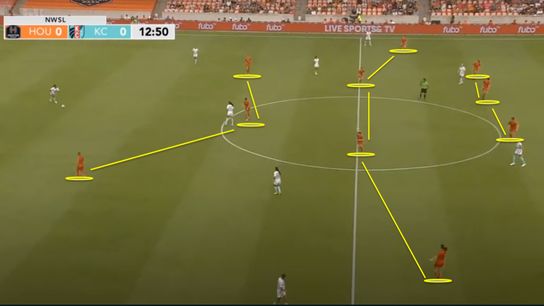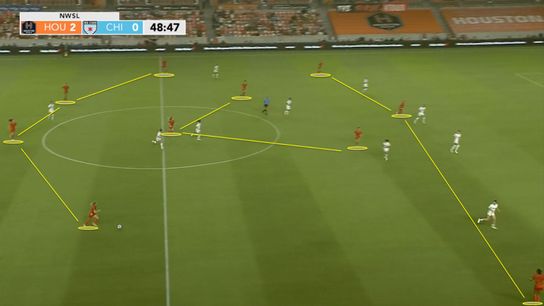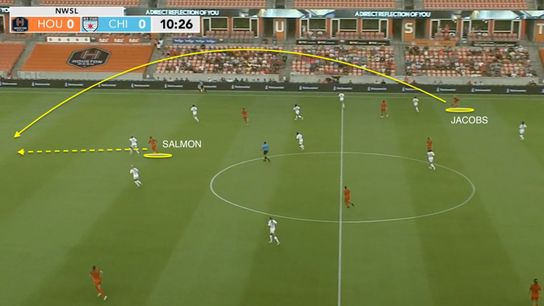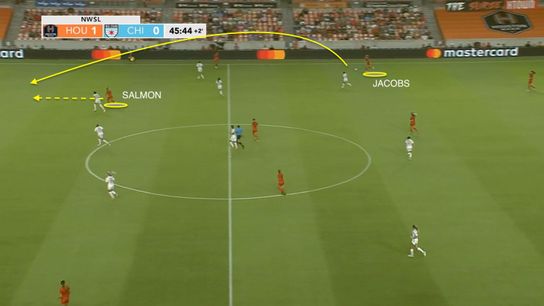With six international players away and two more starters out due to COVID-19 protocols, Juan Carlos Amorós managed to mastermind a brilliant 4-1 win for the Houston Dash over the Chicago Red Stars on Saturday night.
The interim head coach and his players said the victory was down to successfully executing the tactical game plan. "The week of work really reflected," said Amorós on Saturday.
Some of that game plan was brand new ideas, and some of it was about refining the principles Sarah Lowdon had already installed.
"He's implemented a lot of new things," said Ebony Salmon, who scored the first hat trick of her career against Chicago, on Saturday. "I think it shows out there tonight that we've listened, we've put in the work. He's tried to push us to do better in many ways. That's meant changing some things and keeping some things the same."
Speaking to the media on Friday, Amorós did try to prepare us for what was to come. He promised his team would be intense, look to press and counter-press, and play a fluid formation that wasn't necessarily one set shape. His premonitions came true.
"We looked probably more like a 4-3-3 and then, when we go to block, it was more of a loop 4-1-4-1. Ryan [Gareis] was much wider on the left. That's why sometimes on the ball it can look more like a 3-4-3. It's a dynamic game. It's a question of understanding different roles and whoever does the role," said Amorós on Saturday.
The Dash dazzled in a tireless opening 20 minutes that saw the Red Stars become almost completely spooked by the relentless energy of Houston's forwards. "We worked a lot on being a team that is aggressive on the high press," said Amorós.
Even as the tempo slowed, and the Dash began to suck in the Red Stars, the concentration of Amorós' team was immense. All the players appeared to know exactly when to commit and when to sit off. As Chicago tried to cluster, Houston found the space. In one word, the Dash was orchestral.
Let's start by looking at the different shapes we've seen from Houston recently:
3-4-1-2 without the ball (vs. KCC)

This formation was the most commonly used under Lowdon. The front three, deployed as two nines and a 10, would often rotate during the game depending on the situation. Here Salmon, Shea Groom, and Joelle Anderson are in the frontline.
In this frame (above) you can see how the Dash used this shape to sit back and absorb pressure. As Elizabeth Ball carries the ball out of the Kansas City defense, Houston is dropping back to block off passing lanes.
At its most defensive, the wing backs would drop into the back three and form a back five. This was the case when the Dash was under heavy pressure from the opposition and either had a lead or was trying to preserve a draw.
4-2-3-1 without the ball (vs. CRS)

In this still (above) you can see how Amorós changed the setup of the team against the Red Stars for a "mid-block" without pressing Chicago on the ball. In the first three matches under Lowdon, this was also a common shape for Houston. But after victory in Portland, the 3-4-1-2 became preferred.
The "double-pivot" of central midfielders, as seen here with Marisa Viggiano and Emily Ogle, is key to the success of this formation. The duo offers a shield in front of the backline and needs to know when to engage the ball and when to sit off.
When the ball is in the opposite third of the pitch, this shape did adjust to become more of a 4-1-4-1 or 4-3-3 as either Ogle or Viggiano becomes a lone defensive midfielder.
This shape also demands less of the fullbacks than the 3-4-1-2. Not too often against the Red Stars did the full backs over-commit and leave space in behind the Dash defensive wings. On a routinely hot summer's night in Houston, the lack of fatigue the Dash showed on Saturday was impressive.
4-3-3 with the ball (vs. CRS)

When the Dash were building attacks on Saturday, the 4-2-3-1 formation shifted into more of a 4-3-3 (above). Wingers Ryan Gareis and Maria Sánchez went very wide to start in this formation.
This shape benefitted Gareis greatly. Previously seen as a left wing back, Gareis was able to remain much higher up the pitch. With less defensive duties, when she got on the ball she was able to surge toward the Chicago goal much quicker and make things happen.
Gareis got her first-ever professional assist against the Red Stars and had three shots on target. That tally was just one behind Salmon, who finished the match with four attempts on goal. The Dash's total of 10 shots on target was also a season high.
"Ryan [Gareis] going down that left was really positive," said Salmon. "We didn't score from them but the crosses she put into the box were really good. It gave their defense questions of whether they go to Ryan or stay with me because we were both giving them problems."
By making the Chicago defense split as much as possible, the Houston wingers also helped create more space for Salmon in the middle. Once the attack develops, Groom can then attack the box on a delayed run plus either Gareis or Sánchez can then also curl their movement more centrally.
Although none of the goals came directly from the Dash building an attack in this shape, it's good to look at how it works and where the players are designed to be.
When in the 4-3-3 and in the 4-2-3-1, one can also see how isolating Salmon potentially gives her more space to run into, compared to when there are two nines. When there are two central forwards there can be less space to run into, as both players have to design their runs around the other.
"The majority of my career I've played as a single nine," Salmon told The Striker back in June. "I think playing as a single nine can isolate you sometimes. Whereas I think playing with two nines, gives you the ability to go in behind or come short."
High pressing
Dash fans have been used to aggressive high-pressing soccer. Under suspended head coach James Clarkson it had become a calling card of the team between 2019 and 2021.
Although the Dash under Lowdon will be best remembered for its diligence, a combination of absorbing opponent's attacks and remaining flexible, there was still some high-pressing during the acting head coach's 11-match stint.
The recent 4-3 road win over the North Carolina Courage, in June 2022, showcased how effective wing backs Haley Hanson and Elizabeth Eddy could be when they became a fourth player to come in from a wide position to help the forwards harass the defense.
But over the past two matches, Houston's antagonistic approach has faded some. Against the Current two weeks ago the Dash seemed particularly reactionary. Matchweek 11's 1-0 loss to the Orlando Pride was another match where Houston lost its vigor and couldn't persist.
A Dash team that wanted to come out and bite at the heels of the opposition was back against the Red Stars.
Amorós' choice to attack in a 4-3-3 also helped give midfielders Groom, Marisa Viggiano and Emily Ogle the freedom to charge forward and commit to challenges. This caught Chicago off guard.
Rather than be matched up in the same shape as the Red Stars, the Dash's aggressive midfield was able to leave their posts and surprise the under-pressure Chicago backline. It takes a lot of energy, concentration, and collaboration to get that type of high press to work. To the team and Amorós' credit, it paid off.
Here is a pressing sequence from a few minutes before the opening goal, keep an eye on how midfielders Viggiano and Ogle push up and become the deepest members of the move while Salmon and Sánchez lead the press in the front.
Aggressive pressing once again resulted in Groom having arguably one of her most effective matches of the season. She notched one assist, created five chances, won 100% of her tackles (2), made two interceptions and had 10 ball recoveries against Chicago. Two of Groom's three assists from the 2022 season have now come from high-pressing situations.
The fullback goes long
Now, you're going to see two images. You will be inclined to think they are the same screen grab, doctored to look like they are taken from different moments during the Dash vs. Red Stars. But I assure you there is no trickery here.
What we really saw on Saturday night was two goals that were identical in their genesis, both sparked by right back Natalie Jacobs, but different in their climax. That genesis is the seemingly simple long ball over the top hit from the full back beyond the opponent's backline.
"We knew we wanted to be more aggressive on the right hand side with Natalie [Jacobs] because of her profile as a right-footed player," said Amorós.

In the first instance (above), Jacobs hits the ball far beyond Salmon. The Dash forward, being marked by Zoe Morse, gives chase on the inviting long pass. Although you could argue the pass was overhit, it is more eventful to play into that space behind Morse rather than closer to Salmon's body.
Under off-the-ball pressure from Salmon, Morse can only pass the ball back to her goalkeeper Emily Boyd. Once Salmon continues her press on Boyd, the Chicago goalkeeper was forced into an attempt to play a short pass left to center back Tatumn Milazzo.
That was when the trap worked and the turnover caused havoc. The Red Stars' defender is beaten to the pass by Shea Groom, who was three yards behind her when Boyd tried to pass to Milazzo. Once Groom had nipped in and won the ball, all she had to do was cut it back to a wide-open Salmon, who then dutifully swept the ball into the back of the net from nine yards.
This goal was the third turnover Houston forced Chicago into during the first 11 minutes of Saturday's match. It encapsulated the aggressive start from Amoros' tactics, Salmon and Groom's switched-on pressing tandem, and Jacobs' vision.

Now here is the second time (above) Jacobs connects on the long passing from the right back position, in the buildup to Salmon's second goal. The situation and pass are almost identical to the first goal. But the key differences are that Salmon was shifted over one spot to her right, lined up against Milazzo instead of Morse, and that Salmon won possession outright.
Jacobs' pass for the second goal was ideal. It was hit slightly shorter than on the first but still far enough in front of Salmon and Morse. If it had been any shorter then it would have asked Salmon to control the ball, and break stride, or offer Milazzo a chance to make a challenge.
Once the pass is hit, Salmon's excellent awareness comes to the fore. She reads the pass perfectly, gets her body in front of Milazzo and races to be the first to connect with the ball in the open field. Judging the flight of the ball, Salmon only needs one touch to fizz the ball past a charging Boyd and into the back of the net.
"We've been working on that long ball in behind because they play three [at the back] and they and they step quite high. So there's that space in behind. And I think one of one of my strengths is running in behind," said Salmon about planning with Jacobs.
"We spoke about it a little before that goal. I just needed to make sure that I was making that run every time I think that goal showed that it was working. And I think obviously, it worked. So it just shows that when you stick to a game plan that's what happens."
These two goals exhibited how the Dash was able to use one passing pattern to achieve different strategic goals. While both goals started using the Jacobs to Salmon connection, one implemented an off-the-ball press in order to score, and the other used a direct on-the-ball combination.

